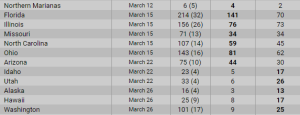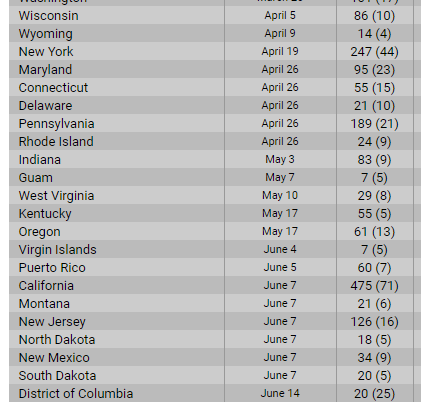Amid Trump hysteria it has not attracted much notice that Bernie Sanders has won five straight Democratic contests. Granted, that comes after a string of seven straight Clinton wins so it's not champagne time by any stretch of the imagination. But five wins beats five losses.
The problem is that those five victories did not do a lot to the numbers because few delegates represent those states. Compare the seven won by Clinton (her delegate count is in the left column, pledged only) to the five won by Sanders (right column) and it's clear that not all wins are created equal in this process.

What his campaign is banking on is that the worst is over and the election now moves into their candidate's wheelhouse. The Alabamas and Utahs and Texases of the primary process are done with and the remaining states are solid Blue on the whole. If he's gonna do well anywhere, this is where you would expect it. Here's an overview of the remaining contests. In this table and throughout this post we're going to ignore the superdelegates in parenthesis; they're likely to support whoever wins the majority of pledged delegates, just as they did in 2008. For now they are sticking with Clinton. If Sanders catches her, most of them will jump ship once again.
The Democratic Party process has 4051 total pledged delegates (PD), meaning the magic number for a majority is 2026. Currently Sanders has 980 and Clinton has 1243. It's not a small margin, but neither is it insurmountably large.
To win the majority of the 4051 total PD count Sanders would need 57.22% of the remaining 1898 PD as of today's date. He's been winning with large percentage majorities in the recent races. Can he keep it up? If he doesn't, he's going to be in trouble by the end of April.

There are two contests before April 19 – WY and WI – with 100 combined PD. For the sake of argument let's say the candidates split those 60 (Sanders) and 40 (Clinton). That would keep the status quo in place until April 19-26, during which six races will occur.
online pharmacy valtrex best drugstore for you
Two of the states, NY and PA, are very large with 247 and 189 PD respectively. If Sanders does not win 60%-plus of the delegates available on April 19 and 26 the math for catching Clinton becomes very difficult. California and New Jersey would represent almost all of the remaining PD after April 26.
The Democrats do not use Winner-take-All rules, so the reality is that both candidates' PD total will inch steadily higher as these races unfold. If Clinton scores a decisive win in a large state at this point, though, it would not be the end of Sanders but the odds would start looking very long. On the other hand, wins in places like New York (where Clinton currently leads significantly in an admittedly small sample of polls). He not only needs to find a way to win, but he needs to win by a margin large enough to start catching up. California is narrowing but Clinton leads there as well.
Without those two, the road to a majority is hard to see.
Not only winning but winning by a 3/5 majority is a tall order for any candidate.
Stranger things have happened, though, and despite falling onto the back burner over the past few weeks the race is far from over. By the end of the day on April 26 we should have a very good idea of how realistic it is for Sanders to catch up. I wouldn't bet my paycheck on that happening, but I wouldn't bet it on Clinton either at this point.
online pharmacy doxycycline best drugstore for you